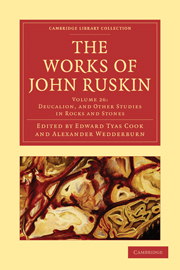Book contents
- Frontmatter
- Contents
- LIST OF ILLUSTRATIONS
- INTRODUCTION TO THIS VOLUME
- I ON THE FORMS OF THE STRATIFIED ALPS OF SAVOY (1863)
- II NOTES ON THE SHAPE AND STRUCTURE OF SOME PARTS OF THE ALPS, WITH REFERENCE TO DENUDATION (1865)
- III ON BANDED AND BRECCIATED CONCRETIONS (1867–1870)
- IV DEUCALION: COLLECTED STUDIES OF THE LAPSE OF WAVES AND LIFE OF STONES (1875–1883)
- V ON THE DISTINCTIONS OF FORM IN SILICA (1884)
- VI CATALOGUES OF MINERALS
- VII THE GRAMMAR OF SILICA (not hitherto published)
- APPENDIX: LETTERS, ADDRESSES, AND NOTES
- I NOTICE RESPECTING SOME ARTIFICIAL SECTIONS ILLUSTRATING THE GEOLOGY OF CHAMOUNI (1858)
- II LETTERS TO THE “READER” ON THE CONFORMATION OF THE ALPS (1864)
- III JAMES DAVID FORBES (1874)
- IV A LECTURE ON STONES (1876)
- V THE ALPINE CLUB AND THE GLACIERS (1878)
- VI INTRODUCTION TO W. G. COLLINGWOOD'S “LIMESTONE ALPS OF SAVOY” (1884)
- VII THE GARNET (1885)
- VIII A GEOLOGICAL RAMBLE IN SWITZERLAND
- INDEX
- Plate section
VIII - A GEOLOGICAL RAMBLE IN SWITZERLAND
Published online by Cambridge University Press: 05 March 2012
- Frontmatter
- Contents
- LIST OF ILLUSTRATIONS
- INTRODUCTION TO THIS VOLUME
- I ON THE FORMS OF THE STRATIFIED ALPS OF SAVOY (1863)
- II NOTES ON THE SHAPE AND STRUCTURE OF SOME PARTS OF THE ALPS, WITH REFERENCE TO DENUDATION (1865)
- III ON BANDED AND BRECCIATED CONCRETIONS (1867–1870)
- IV DEUCALION: COLLECTED STUDIES OF THE LAPSE OF WAVES AND LIFE OF STONES (1875–1883)
- V ON THE DISTINCTIONS OF FORM IN SILICA (1884)
- VI CATALOGUES OF MINERALS
- VII THE GRAMMAR OF SILICA (not hitherto published)
- APPENDIX: LETTERS, ADDRESSES, AND NOTES
- I NOTICE RESPECTING SOME ARTIFICIAL SECTIONS ILLUSTRATING THE GEOLOGY OF CHAMOUNI (1858)
- II LETTERS TO THE “READER” ON THE CONFORMATION OF THE ALPS (1864)
- III JAMES DAVID FORBES (1874)
- IV A LECTURE ON STONES (1876)
- V THE ALPINE CLUB AND THE GLACIERS (1878)
- VI INTRODUCTION TO W. G. COLLINGWOOD'S “LIMESTONE ALPS OF SAVOY” (1884)
- VII THE GARNET (1885)
- VIII A GEOLOGICAL RAMBLE IN SWITZERLAND
- INDEX
- Plate section
Summary
Only half of the town of Lucerne remains, the rest having been destroyed, and a mass of hotels built on its ruins. The huge barracks beside the Reuss stand on the site of one of its most picturesque groups of gate and wall. But by a strong effort of fancy the traveller may still imagine the old town running round the extremity of the lake, with narrow quays before its old-fashioned houses, connected, by the long covered bridge which yet remains, with the large suburb on the other side of the Reuss, and by another, now destroyed, with the eastern shore near the cathedral; the whole group defended from an attack on the land side by the chain of walls and towers, of which a portion yet remains on the grassy hill behind the town (the walks about this and the immediately succeeding hills between it and the Rothsee used to be among the most exquisite in Switzerland). The eminence which carries the towers is caused by a sharp elevation of the beds of the molasse sandstone, as may be clearly seen in the quarry on the other side of the Reuss, on the old Berne road. That road, about a mile and a half from Lucerne, crosses a picturesque dingle in this same sandstone, by which the torrent from the northernmost spurs of Pilate joins the Emme. There is a road through the ravine, and the opening view of Mount Pilate from the top of the hill is of singular loveliness.
- Type
- Chapter
- Information
- The Works of John Ruskin , pp. 577 - 580Publisher: Cambridge University PressPrint publication year: 2010First published in: 1906



